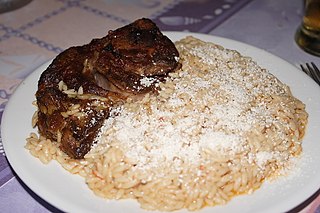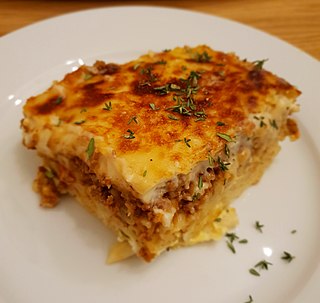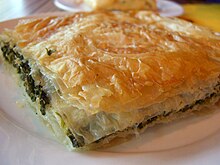
Greek cuisine is the cuisine of Greece and the Greek diaspora. In common with many other cuisines of the Mediterranean, it is founded on the triad of wheat, olive oil, and wine. It uses vegetables, olive oil, grains, fish, and meat, including pork, poultry, veal and beef, lamb, rabbit, and goat. Other important ingredients include pasta, cheeses, lemon juice, herbs, olives and olive oil, and yogurt. Bread made of wheat is ubiquitous; other grains, notably barley, are also used, especially for paximathia. Common dessert ingredients include nuts, honey, fruits, sesame, and filo pastries. It continues traditions from Ancient Greek and Byzantine cuisine, while incorporating Turkish, Balkan, and Italian influences.

Turkish cuisine is the cuisine of Turkey and the Turkish diaspora. Although the cuisine took its current rich form after numerous cultural interactions throughout centuries, it should not be confused with other cuisines such as Ottoman cuisine or Seljuk cuisine. Turkish cuisine with traditional Turkic elements such as yogurt, ayran, kaymak, exerts and gains influences to and from Mediterranean, Balkan, Middle Eastern, Central Asian and Eastern European cuisines.

Pirozhki are foremost, Russian baked or fried yeast-leavened boat-shaped buns with a variety of fillings. Pirozhki are a popular street food and comfort food in Eastern Europe.
Romanian cuisine is a diverse blend of different dishes from several traditions with which it has come into contact, but it also maintains its own character. It has been mainly influenced by Turkish but also a series of European cuisines in particular from the Balkan Peninsula and Hungarian cuisine as well as culinary elements stemming from the cuisines of Central Europe.

Filo is a very thin unleavened dough used for making pastries such as baklava and börek in Middle Eastern and Balkan cuisines. Filo-based pastries are made by layering many sheets of filo brushed with oil or butter; the pastry is then baked.

Pastitsio is a Greek baked pasta dish with ground meat and béchamel sauce, with variations of the dish found in other countries of the Mediterranean Sea.

Bulgarian cuisine is part of the cuisine of Southeast Europe, sharing characteristics with other Balkan cuisines. Bulgarian cooking traditions are diverse because of geographical factors such as climatic conditions suitable for a variety of vegetables, herbs, and fruit. Aside from the variety of local Bulgarian dishes, Bulgarian cuisine shares a number of dishes with its neighboring countries, in particular with Turkish and Greek cuisine.

Banitsa, also transliterated as banica and banitza, is a traditional pastry made in Bulgaria. It is also made in Budjak, where it is known as milina by Ukrainian Bulgarians; North Macedonia; and southeastern Serbia. In southeastern Serbia, it may also be known as gibanica. Banitsa is prepared by layering a mixture of whisked eggs, plain yogurt, and pieces of white brined cheese between filo pastry and then baking it in an oven.

Börek or burek is a family of pastries or pies found in the Balkans, Middle East and Central Asia. The pastry is made of a thin flaky dough such as filo with a variety of fillings, such as meat, cheese, spinach, or potatoes. Boreks are mainly associated with the Middle East, Caucasus, and also with the former Ottoman Empire, including the Balkans and the South Caucasus, Eastern European and Central European countries, Northern Africa and Central Asia. A borek may be prepared in a large pan and cut into portions after baking, or as individual pastries. They are usually baked but some varieties can be fried. Borek is sometimes sprinkled with sesame or nigella seeds, and it can be served hot or cold.

Gözleme is a savory Turkish stuffed turnover. The dough is usually unleavened, and made only with flour, salt and water, but gözleme can be made from yeast dough as well. It is similar to bazlama, but is lightly brushed with butter or oil, whereas bazlama is prepared without fat. The dough is rolled thin, then filled with various toppings, sealed, and cooked over a griddle. Gözleme may sometimes be made from prepackaged hand-rolled leaves of yufka dough.

Bougatsa is a Greek breakfast food, or mid-morning snack, or midday snack. Bougatsa has several versions with their own filling, with the most popular the bougatsa krema that has semolina custard filling uses as a sweet food and dessert.

Gibanica is a traditional pastry dish popular all over the Balkans. It is usually made with cottage cheese and eggs. Recipes can range from sweet to savoury, and from simple to festive and elaborate multi-layered cakes.

Bourekas or burekas are a popular baked pastry in Sephardic Jewish cuisine and Israeli cuisine. A variation of the burek, a popular pastry throughout southern Europe, northern Africa and the Middle East, Israeli bourekas are made in a wide variety of shapes and a vast selection of fillings, and are typically made with either puff pastry, filo dough, or brik pastry, depending on the origin of the baker.
Bosnian cuisine is the traditional cuisine of Bosnia and Herzegovina. It is influenced by Ottoman, Austro-Hungarian and Balkan cuisines.

Zelnik is a traditional pastry eaten in Bulgaria and North Macedonia. It is composed of layers of thinly-rolled leavened wheat flour dough, or possibly phyllo pastry, filled with various combinations of sirene, feta cheese, eggs, sorrel, browned meat, leeks, spring onions and/or rice. In winter, the filling traditionally includes pickled cabbage, from which the dish derives its name. Bulgarian zelnik could be made also with various wild and cultivated leafy greens like collard, lettuce, orache, rumex, Chenopodium album, spearmint and many others. Zelnik is sometimes served with yogurt and it is best eaten warm.
The cuisine of Kosovo is a representative of the cuisine of the Balkans and consists of traditional dishes by ethnic groups native to Kosovo. Due to ethnic connections with Albania, it has been significantly influenced by Albanian cuisine and has adopted elements of other Balkan countries.

Lakror is a traditional and common regional Albanian pie dish of Albania made with different fillings consisting of various vegetables or meat.

The peinirli is an elongated, open pie made in a boat shape. They contain a substantial amount of yellow cheese and optionally, meats or vegetables. Peinirli originated in Turkey, where it is known as peynirli. There are two types of pide: peynirli pide, in which cheese entirely covers the surface of the filling and karışık pide, which has cheese only as part of the filling.
Bulemas or boulemas, also rodanches or burmaikos, are a traditional baked pastry in Sephardic Jewish cuisine. They are made from a yeast dough that is thinly stretched and filled with a savory mixture, and then rolled into a spiral shape. Once baked, the pastry boasts a delicate and flaky texture akin to that of phyllo-based pastries, like the Turkish Kol böreği and the Greek spanakopita.
















